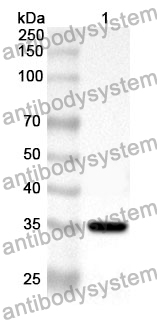Catalog No.
PHD45901
Species reactivity
Human
Host species
Rabbit
Isotype
IgG
Clonality
Polyclonal
Immunogen
E. coli - derived recombinant Human FPR1 (Arg163-Val242).
Tested applications
ELISA: 1:4000-1:8000, IHC: 1:50-1:100, WB: 1:1000-1:4000
Target
fMet-Leu-Phe receptor,fMLP receptor,N-formyl peptide receptor,FPR,FPR1,N-formylpeptide chemoattractant receptor
Purification
Purified by antigen affinity column.
Accession
P21462
Applications
ELISA, IHC, WB
Form
Liquid
Storage buffer
0.01M PBS, pH 7.4, 50% Glycerol, 0.05% Proclin 300.
Stability and Storage
Use a manual defrost freezer and avoid repeated freeze thaw cycles. Store at 2 to 8°C for frequent use. Store at -20 to -80°C for twelve months from the date of receipt.
Increased expression of formyl peptide receptor-1 by basophils from patients with mastocytosis., PMID:39148513
Removal of circulating mitochondrial N-formyl peptides via immobilized antibody therapy restores sepsis-induced neutrophil dysfunction., PMID:39107254
A therapeutic antibody targeting annexin-A1 inhibits cancer cell growth in vitro and in vivo., PMID:38200229
Hepatocyte-secreted FAM3D ameliorates hepatic steatosis by activating FPR1-hnRNP U-GR-SCAD pathway to enhance lipid oxidation., PMID:37454871
Targeting cytokine-like protein FAM3D lowers blood pressure in hypertension., PMID:37301198
The study of genetic predisposition on periodontitis and peri-implantitis., PMID:36412285
Identified potential biomarkers may predict primary nonresponse to infliximab in patients with ulcerative colitis., PMID:35876170
Neutrophil activation in patients with anti-neutrophil cytoplasmic autoantibody-associated vasculitis and large-vessel vasculitis., PMID:35768848
Mitofusin-2 regulates leukocyte adhesion and β2 integrin activation., PMID:34494308
Activation of formyl peptide receptor 1 elicits therapeutic effects against collagen-induced arthritis., PMID:34378309
New Pieces in the Puzzle of uPAR Role in Cell Migration Mechanisms., PMID:33255171
Dynamics of Cardiac Neutrophil Diversity in Murine Myocardial Infarction., PMID:32811295
D-Peptide analogues of Boc-Phe-Leu-Phe-Leu-Phe-COOH induce neovascularization via endothelial N-formyl peptide receptor 3., PMID:32152757
Formyl Peptide Receptor-1 Blockade Prevents Receptor Regulation by Mitochondrial Danger-Associated Molecular Patterns and Preserves Neutrophil Function After Trauma., PMID:31939811
FPR1 is the plague receptor on host immune cells., PMID:31534221
G-protein-coupled formyl peptide receptors play a dual role in neutrophil chemotaxis and bacterial phagocytosis., PMID:30540534
A novel MtHSP70-FPR1 fusion protein enhances cytotoxic T lymphocyte responses to cervical cancer cells by activating human monocyte-derived dendritic cells via the p38 MAPK signaling pathway., PMID:30098789
Deficiency of FAM3D (Family With Sequence Similarity 3, Member D), A Novel Chemokine, Attenuates Neutrophil Recruitment and Ameliorates Abdominal Aortic Aneurysm Development., PMID:29853563
Intracellular formyl peptide receptor regulates naïve CD4 T cell migration., PMID:29427663
Targeting the cross-talk between Urokinase receptor and Formyl peptide receptor type 1 to prevent invasion and trans-endothelial migration of melanoma cells., PMID:29216889
The spleen contributes importantly to myocardial infarct exacerbation during post-ischemic reperfusion in mice via signaling between cardiac HMGB1 and splenic RAGE., PMID:27645145
The role of formyl peptide receptor 1 (FPR1) in neuroblastoma tumorigenesis., PMID:27432059
Microenvironment involved in FPR1 expression by human glioblastomas., PMID:25894595
Pharmacological profile of a bifunctional ligand of the formyl peptide receptor1 fused to the myc epitope., PMID:25681283
Role of intracellular and extracellular annexin A1 in migration and invasion of human pancreatic carcinoma cells., PMID:25510623
Affinity maturation of a novel antagonistic human monoclonal antibody with a long VH CDR3 targeting the Class A GPCR formyl-peptide receptor 1., PMID:25484051
Human neutrophil formyl peptide receptor phosphorylation and the mucosal inflammatory response., PMID:25395303
An annexin A1-FPR1 interaction contributes to necroptosis of keratinocytes in severe cutaneous adverse drug reactions., PMID:25031270
Parallel affinity-based isolation of leukocyte subsets using microfluidics: application for stroke diagnosis., PMID:24650222
The urokinase receptor takes control of cell migration by recruiting integrins and FPR1 on the cell surface., PMID:24466048
Identification of C-terminal phosphorylation sites of N-formyl peptide receptor-1 (FPR1) in human blood neutrophils., PMID:23873933
Involvement of formyl peptide receptors in receptor for advanced glycation end products (RAGE)--and amyloid beta 1-42-induced signal transduction in glial cells., PMID:23164356
Annexin 1 released by necrotic human glioblastoma cells stimulates tumor cell growth through the formyl peptide receptor 1., PMID:21782780
Omega-3 fatty acid-derived mediators 17(R)-hydroxy docosahexaenoic acid, aspirin-triggered resolvin D1 and resolvin D2 prevent experimental colitis in mice., PMID:21724996
N-formyl peptide receptor 3 (FPR3) departs from the homologous FPR2/ALX receptor with regard to the major processes governing chemoattractant receptor regulation, expression at the cell surface, and phosphorylation., PMID:21543323
Activation of formyl peptide receptor-1 enhances restitution of human retinal pigment epithelial cell monolayer under electric fields., PMID:21228377
Mitochondrial peptides are potent immune activators that activate human neutrophils via FPR-1., PMID:20539176
Anti-angiogenesis effect of the novel anti-inflammatory and pro-resolving lipid mediators., PMID:19407006
BML-111, a lipoxin receptor agonist, modulates the immune response and reduces the severity of collagen-induced arthritis., PMID:18648754
Variable responses of formyl peptide receptor haplotypes toward bacterial peptides., PMID:18253729
Formyl peptide receptor expression in birds., PMID:17464763
A novel FK506- and rapamycin-binding protein (FPR3 gene product) in the yeast Saccharomyces cerevisiae is a proline rotamase localized to the nucleolus., PMID:7525596

